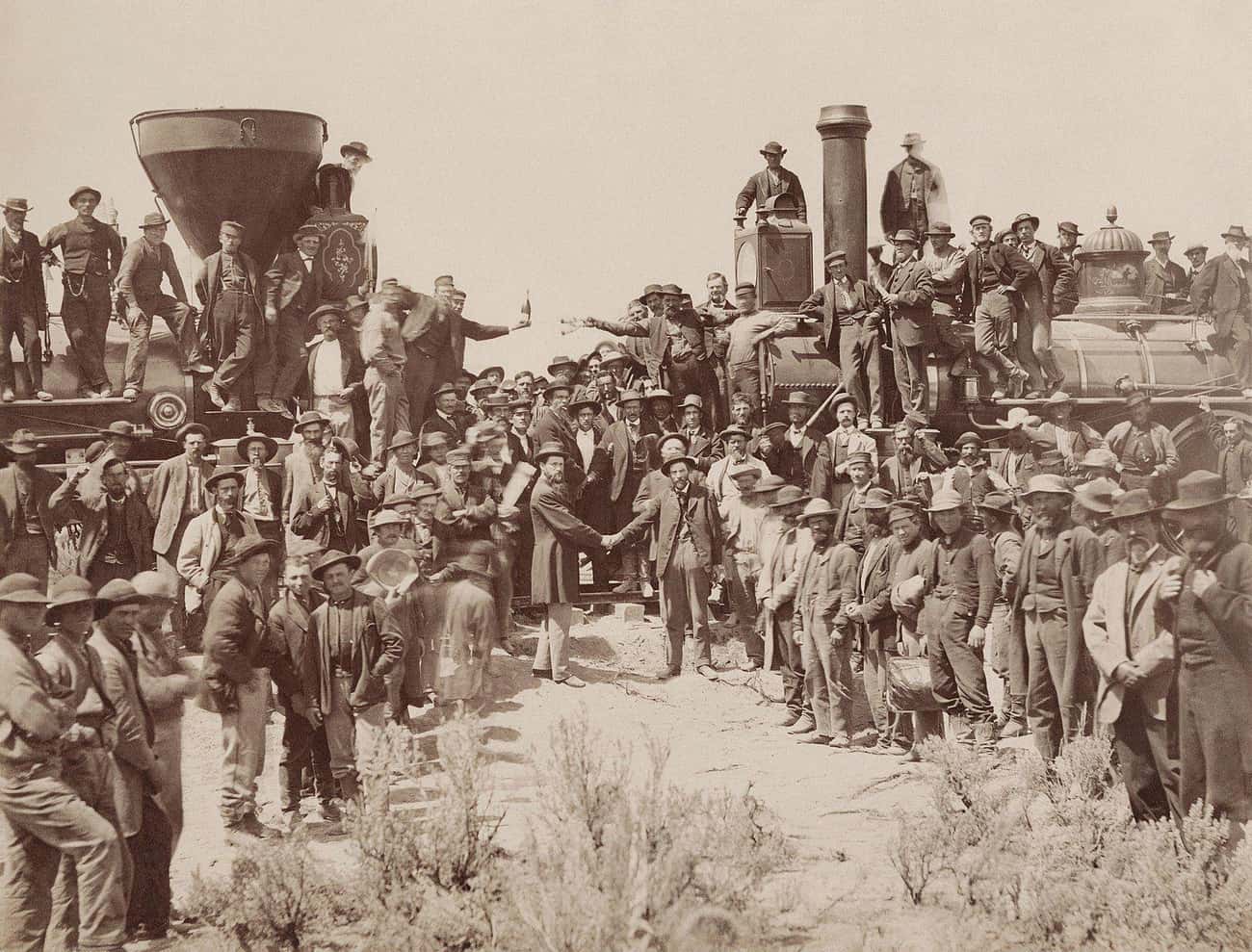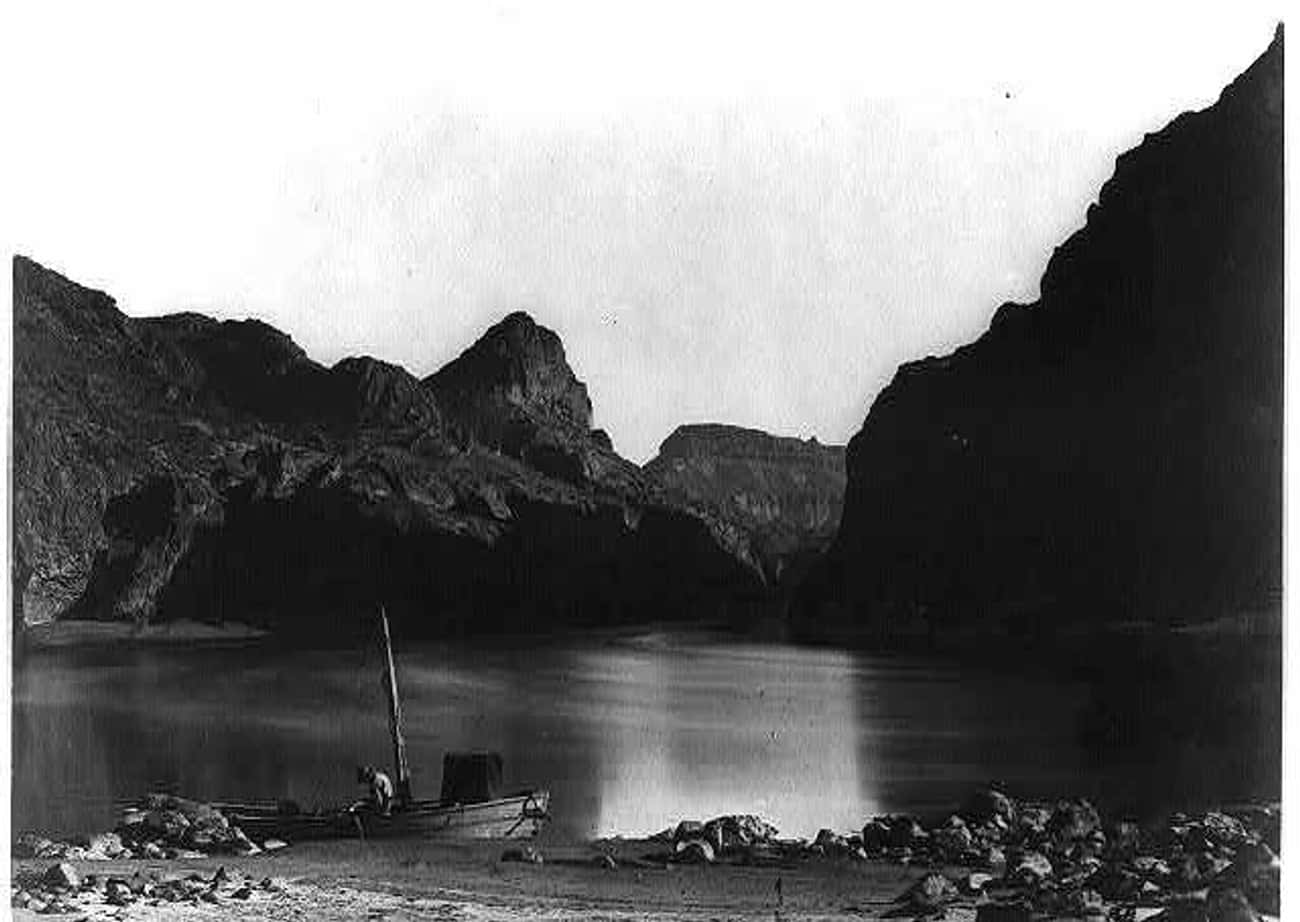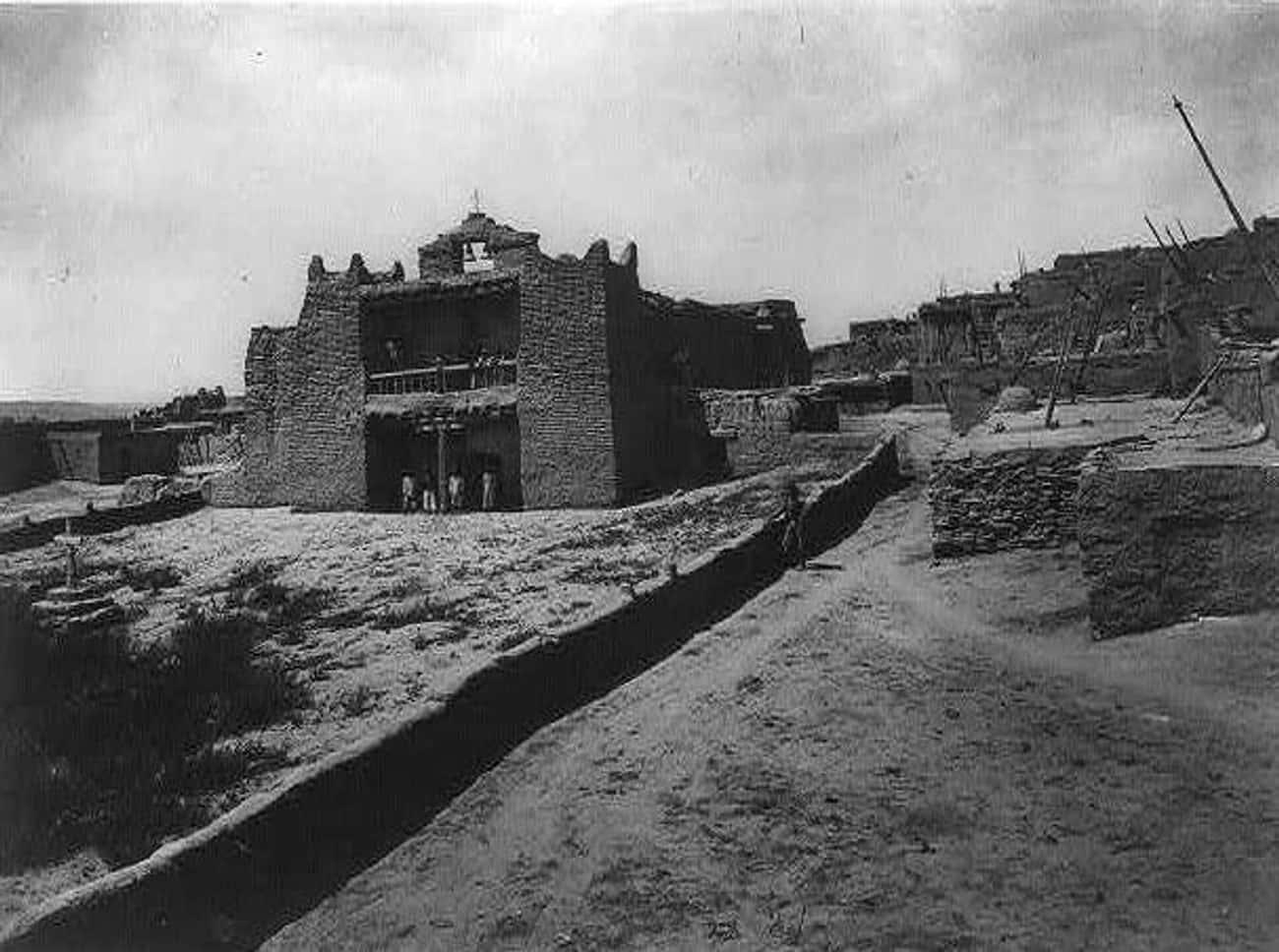In the late 1800s, the western United States attracted numerous new residents seeking opportunities in unexplored territories. However, the journey was challenging, with bandits, vast wilderness, and conflicts with native inhabitants.
These authentic Old West photos, including a rare image of Billy the Kid, provide a glimpse into life in this untamed frontier. These pictures reveal that the real 1800s America was far different from the romanticized portrayal seen in Western movies.
They offer insights into what the United States looked like in the 19th century and provide answers to questions about life in the Wild West.
Billy the Kid, C. 1879


Billy the Kid, born as William Henry McCarty Jr. around 1859, is a legendary figure in the American Old West. He gained notoriety for his involvement in the Lincoln County War in New Mexico during the late 1870s, where he became an outlaw known for cattle rustling, theft, and murder.
His criminal activities were widely reported in newspapers, contributing to his fame. He is believed to have killed several individuals, though the exact number remains debated.
Billy the Kid was ultimately shot and killed by Sheriff Pat Garrett in 1881 at the age of around 21. His life and exploits have inspired numerous books, films, and songs, cementing his status as an iconic figure in Wild West history.
Doc Holliday, Gambler, Gunfighter, Dentist, 1879
Doc Holliday, also known as John Henry Holliday, was a notable figure in the American Old West. Originally a dentist, he ventured west due to tuberculosis and became known for his gambling and gunfighting skills.
His most famous association was with Wyatt Earp, and he participated in the infamous gunfight at the O.K. Corral in Tombstone, Arizona. Holliday faced legal troubles throughout his life and suffered from tuberculosis.
He eventually died from the disease in Glenwood Springs, Colorado, in 1887, at the age of 36.


Navajo Family Near Fort Defiance, 1873
The Navajo, also known as the Diné, are one of the largest and most prominent Native American tribes in the United States. They reside primarily in the southwestern Four Corners region, encompassing Arizona, New Mexico, Utah, and Colorado.
The Navajo culture is characterized by their unique language, Diné Bizaad, and their historical lifestyle, which included herding, agriculture, and traditional crafts like rug weaving and jewelry-making.
They played a vital role as Code Talkers in World War II, transmitting secure military messages.
The Navajo experienced the forced relocation known as the “Long Walk” in the 1860s but have since become a sovereign nation within the United States, known as the Navajo Nation.


Paiute Native Americans, 1872
The Paiute Native Americans are Indigenous peoples of the Great Basin region in the western United States. They speak various Paiute languages, with distinct dialects among different groups.
Traditionally, they were hunter-gatherers with a unique adaptation to the arid environment. The Paiute culture includes traditions, ceremonies, and artistic expressions like basket weaving.
They faced challenges during westward expansion but maintain their cultural heritage and sovereignty in contemporary communities, engaging in various economic activities.


Sioux Camp, 1890
A Sioux camp refers to a traditional settlement or encampment inhabited by the Sioux Nation, also known as the Dakota, Nakota, and Lakota, Indigenous peoples of the Great Plains region.
These camps typically featured tipis (or teepees), circular or semi-circular arrangements, and served as the dwelling places for the nomadic Sioux people.
The Sioux followed a nomadic lifestyle, relying on bison for food, clothing, and shelter. Sioux camps were centers for cultural, social, and spiritual activities, including ceremonies and communal gatherings.
However, encounters with European settlers and westward expansion led to conflicts and eventual confinement to reservations, marking a significant change in their way of life.


Young Jesse James, 1864
Jesse James was a notorious American outlaw born in 1847 in Missouri. He, along with his brother Frank James, formed the James-Younger Gang, known for bank and train robberies during the American Old West era.
These actions made Jesse James a feared figure in the Midwest. While some saw him as a folk hero, he was assassinated in 1882 by a member of his gang, Robert Ford.


Wyatt Earp
Wyatt Earp was a renowned figure in the American Old West, known for his law enforcement career and his role in the famous gunfight at the O.K. Corral in Tombstone, Arizona, in 1881.
Born in 1848, Earp worked as a lawman in various frontier towns and, along with his brothers and Doc Holliday, confronted outlaws in the iconic O.K. Corral shootout.
His life and exploits have been the subject of numerous books, films, and legends, making him an enduring symbol of the Wild West.


The Completion Of The Transcontinental Railroad, 1869
The completion of the Transcontinental Railroad in 1869 was a landmark event in American history. It realized the long-held vision of connecting the East and West Coasts of the United States through a railway system.
The project involved the Central Pacific Railroad building eastward from Sacramento, California, and the Union Pacific Railroad building westward from Omaha, Nebraska.
The two lines met at Promontory Summit, Utah, where a golden spike was driven into a railroad tie to symbolize completion.
This monumental achievement had far-reaching impacts, including economic growth, westward expansion, and technological advancements.


The Deadwood Coach, 1889
The Deadwood Coach was a stagecoach line that operated during the late 19th century, primarily serving the mining town of Deadwood in the Black Hills of South Dakota during the Gold Rush era.
It played a crucial role in transporting people, mail, and goods in a rugged and often dangerous frontier environment.
Notable passengers included Wild West figures like Wild Bill Hickok, Calamity Jane, and Seth Bullock.
As the Gold Rush subsided and railroads expanded, stagecoach travel declined.


Canyon De Chelly, 1873
Canyon de Chelly, located in northeastern Arizona, is a geological marvel and a culturally significant site within the traditional homeland of the Navajo Nation.
Formed by millions of years of erosion, the canyon is known for its steep cliffs, colorful rock formations, ancient cliff dwellings, and rock art left behind by the Ancestral Puebloan people. It holds deep cultural and spiritual importance for the Navajo.
The Canyon de Chelly National Monument, managed by the National Park Service in collaboration with the Navajo Nation, welcomes tourists who can explore the canyon’s natural beauty and cultural history through hiking, guided tours, and rim drives.
Spider Rock, a prominent sandstone spire, is one of its iconic features.


Big Nose Kate, Doc Holliday’s Wife, C. 1890
Big Nose Kate, also known as Mary Katherine Horony-Cummings, was a prominent figure in the American Old West. Born in Hungary, she later immigrated to the United States and gained her nickname due to her prominent nose.
She is best known for her romantic relationship with the legendary gambler and gunfighter Doc Holliday. Their association with the tumultuous events of the Wild West, including time in Tombstone, Arizona, is a part of her legacy.
After Holliday’s death, she lived a colorful life, marrying multiple times and running a hotel.


Villa Of Brule, 1891
The Villa of Brulé, also known as Brulé Village, was a historic Native American settlement located along the Missouri River in what is now South Dakota. This village was associated with the Brulé tribe, a subgroup of the Lakota Sioux Nation.
The Brulé people lived in tipis and engaged in hunting, fishing, and trading.
Over time, like many Native American communities, the Brulé faced challenges due to westward expansion, the fur trade, and the encroachment of European settlers.


Barmen Tend To An Old West Saloon, 1897
Old West saloons were central social hubs in frontier towns during the 19th century American frontier. These establishments primarily served alcoholic beverages, featured gambling tables, and often hosted live entertainment.
Saloons were places for socializing, news-sharing, and local discussion, playing a significant role in the frontier communities’ social fabric. They had distinct decor and a lively atmosphere, becoming iconic in Western lore and media.
However, their era declined as frontier settlements evolved, and alcohol regulations tightened due to the temperance movement.


Louisa Earp, Morgan Earp’s Wife, Before 1895
Louisa Earp, also known as Louisa Houston Earp, was the wife of Morgan Earp, one of the Earp brothers famous for their roles in the American Old West. She married Morgan shortly before the infamous gunfight at the O.K. Corral in Tombstone, Arizona.
Louisa and Morgan settled in Tombstone, where they became part of the Earp family’s tumultuous life. Morgan was wounded in the O.K. Corral shootout, and tragically, he was later assassinated in 1882.
After his death, Louisa faced the challenges of widowhood in the Old West and eventually remarried.


‘Texas Jack’ Vermillion, Gunfighter
“Texas Jack” Vermillion, born John Wilson Vermillion, was a prominent figure in the American Old West. He earned his nickname due to his involvement in the Texas cattle industry.
After serving as a Confederate soldier in the American Civil War, he became a Wild West performer known for buffalo hunting, roping, and marksmanship.
He toured with “Buffalo Bill” Cody’s Wild West show and had a close friendship with “Wild Bill” Hickok.
Texas Jack Vermillion was briefly married to “Calamity Jane.”


Mattie Blaylock, Wyatt Earp’s Wife, Before 1888
Mattie Blaylock was a historical figure associated with the American Old West and briefly known as Wyatt Earp’s common-law wife. Her exact birth details are unclear, but she lived in various Western towns, including Tombstone, Arizona, during its mining boom.
Mattie had a relationship with Wyatt Earp during his time in Tombstone, although they were not officially married. She was present during the infamous gunfight at the O.K. Corral in 1881.
After Wyatt Earp left Tombstone, her life took a tragic turn, and she died in 1888, reportedly by suicide.


Storefronts Tout Their Wares, 1888
In 1888, storefronts in towns and cities varied in architectural styles and features, reflecting the era’s design trends.
Common elements included wooden facades with ornate details, large display windows, gas lamps for lighting, decorative signage, fabric awnings, and wooden sidewalks.
These storefronts housed a diverse range of businesses, from general stores to saloons, and used various forms of advertising to attract customers.


Buffalo Soldier, 1890
Buffalo Soldiers were African American soldiers who served in segregated units of the U.S. Army in the western frontier following the American Civil War.
Despite facing discrimination, they gained a reputation for their bravery and effectiveness in various military operations, including the Indian Wars and the Spanish-American War.
Their legacy is one of resilience and contributions to the development of the American West.
Over time, they have received greater recognition for their service and sacrifices, with monuments and historical sites commemorating their history.


Ike Clanton, Outlaw, 1881
Ike Clanton was a historical figure associated with the American Old West, notably known for his involvement in the events leading up to the gunfight at the O.K. Corral in Tombstone, Arizona.
He was part of the Clanton family and had conflicts with lawmen, including the Earp brothers and Doc Holliday.
The O.K. Corral shootout on October 26, 1881, involved Ike Clanton and the Cowboys, leading to a brief but deadly confrontation. Following the gunfight, Ike Clanton faced legal proceedings but was not charged.


Shoshone Falls, 1874
Shoshone Falls, often called the “Niagara of the West,” is a remarkable natural waterfall located on the Snake River in southern Idaho, USA. It stands approximately 212 feet tall, making it higher than Niagara Falls.
The falls are known for their breathtaking natural beauty, surrounded by basalt canyon walls and lush greenery.
Shoshone Falls Park provides viewing areas, picnicking spots, and recreational activities for visitors to enjoy the splendor of this iconic American waterfall.
It holds cultural significance for indigenous peoples and remains a popular tourist attraction, drawing visitors to witness its grandeur throughout the year.


Montana Mine, 1889
The “Montana Mine” in 1889 likely referred to a mining operation or facility in the state of Montana during that year.
Montana experienced a significant mining boom in the late 19th century, attracting miners and investors seeking valuable minerals like gold, silver, copper, and lead.
This industry led to the growth of boomtowns, contributed to Montana’s economic development, and required a substantial labor force. Mining methods included placer mining, hard rock mining, and hydraulic mining.


The Pyramid And Domes At Pyramid Lake, Nevada, 1867
The Pyramid and Domes at Pyramid Lake are natural geological formations located in Pyramid Lake, Nevada.
The Pyramid is a prominent conical-shaped rocky promontory on the eastern shore of the lake, while the Domes, also known as the “Stone Mother,” are a cluster of rounded rock formations nearby.
These formations, set against the backdrop of the striking blue waters of the lake, are not only visually captivating but also hold cultural and spiritual significance for the Pyramid Lake Paiute Tribe.


The Bath House At Hot Springs, 1891
Bathhouses and hot springs in the late 1800s were sought-after destinations known for their therapeutic properties and social appeal.
These facilities, often constructed near natural hot springs, provided controlled environments for visitors to bathe in mineral-rich waters believed to have healing qualities.
They also served as social centers, offering recreational activities and entertainment.


Green River City, Wyoming, 1872
In 1872, Green River City, Wyoming, was a town situated in the southwestern part of the United States.
It owed much of its growth and economic development to the presence of the Union Pacific Railroad, which passed through the area as part of the First Transcontinental Railroad completed in 1869.
The town’s economy was based on transportation-related industries and agriculture, reflecting the broader trends of westward expansion during the late 19th century.
Green River City existed within the rugged and remote landscape of the American West, and historical photographs from this era provide a visual record of its history.


Buffalo Bill’s Wild West Show, 1890
Buffalo Bill’s Wild West Show in 1890 was a renowned traveling entertainment extravaganza founded by William “Buffalo Bill” Cody.
This show aimed to recreate the excitement and drama of the American West, featuring a diverse cast of performers portraying cowboys, Native Americans, sharpshooters, and other frontier figures.
The show included reenactments of historical events, such as stagecoach robberies and buffalo hunts, to both entertain and educate the public about the West.
Buffalo Bill’s Wild West Show also embarked on successful international tours, leaving a lasting legacy in the realm of Wild West-themed entertainment and shaping the popular image of the American West in culture and history.


Black Cañon Colorado River, 1871
In 1871, Black Cañon on the Colorado River was a striking natural gorge located in the southwestern United States. This dramatic geological formation featured steep cliffs, towering rock formations, and a narrow chasm created by the erosive forces of the Colorado River over millions of years.
During the late 19th century, the exploration and documentation of such natural wonders were important as the American West was still relatively uncharted territory.
Advancements in photography during this era allowed for the capture of images showcasing the rugged beauty of Black Cañon.


Gold Hill, Nevada, 1870s
During the 1870s, Gold Hill, Nevada, was a prominent mining town located within the Comstock Lode mining district in the western United States. The town was at the heart of a significant mining boom driven by the discovery of valuable silver and gold deposits.
This boom led to a rapid increase in population as prospectors, miners, and investors flocked to the area in search of their fortunes. Gold Hill’s economy thrived on the extraction of precious metals, contributing to Nevada’s growth and development.
The town featured various mining techniques, infrastructure, and a bustling community.
However, like many mining towns, Gold Hill faced a decline in mining activity as ore quality diminished, marking the end of its boom period.


William ‘Curly Bill’ Brocius, Gunman, Rustler, Outlaw Cowboy
William “Curly Bill” Brocius was a notorious cowboy and outlaw in the late 19th-century American West. He was associated with the Cochise County Cowboys, a group known for cattle rustling and conflicts with lawmen.
Although he wasn’t present at the Gunfight at the O.K. Corral in Tombstone, Arizona, his association with the Cowboys tied him to the infamous event. Curly Bill had a violent reputation and was involved in various confrontations and shootouts during his criminal career.
He met a violent end, reportedly killed in a shootout in 1882, although the circumstances of his death remain debated.


Old Mission Church, Zuni Pueblo, New Mexico, 1873
In 1873, the Old Mission Church located in Zuni Pueblo, New Mexico, was a culturally and historically significant site. It represented the blending of Spanish Catholicism with indigenous Zuni traditions.
Constructed using adobe and featuring distinctive Southwestern architectural elements, the church played a central role in the religious and cultural life of the Zuni community.
Despite the Spanish influence, the Zuni people maintained their cultural practices alongside Catholicism.


Nicholas And Virginia Earp, Parents Of Wyatt Earp
Nicholas and Virginia Earp were the parents of Wyatt Earp, the renowned lawman of the American West. They married in 1840 and had a family that included several children.
The family initially lived in Illinois and later moved to Pella, Iowa, before reuniting in California. In 1864, Nicholas Earp joined the California Gold Rush.
Their values and upbringing had a significant influence on Wyatt Earp’s sense of justice and his later career as a lawman and gambler in the Old West.


Please SHARE this with your friends and family.







